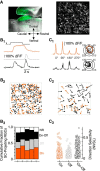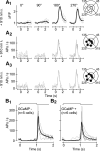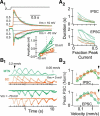Projection-specific characteristics of retinal input to the brain
- PMID: 25904807
- PMCID: PMC4405563
- DOI: 10.1523/JNEUROSCI.4298-14.2015
Projection-specific characteristics of retinal input to the brain
Abstract
The brain receives information about the direction of object motion from several types of retinal ganglion cells (RGCs). On-Off direction-selective (DS) RGCs respond preferentially to stimuli moving quickly in one of four directions and provide a significant (but difficult to quantify) fraction of RGC input to the SC. On DS RGCs, in comparison, respond preferentially to stimuli moving slowly in one of three directions and are thought to only target retinorecipient nuclei comprising the accessory optic system, e.g., the medial terminal nucleus (MTN). To determine the fraction of SC-projecting RGCs that exhibit direction selectivity, and the specificity with which On-Off and On DS RGCs target retinorecipient areas, we performed optical and electrophysiological recordings from RGCs retrogradely labeled from the mouse SC and MTN. We found, surprisingly, that both On-Off and On DS RGCs innervate the SC; collectively they constitute nearly 40% of SC-projecting RGCs. In comparison, only On DS RGCs project to the MTN. Subsequent experiments revealed that individual On DS RGCs innervate either the SC or MTN and exhibit robust projection-specific differences in somatodendritic morphology, cellular excitability, and light-evoked activity; several projection-specific differences in the output of On DS RGCs correspond closely to differences in excitatory synaptic input the cells receive. Our results reveal a robust projection of On DS RGCs to the SC, projection-specific differences in the response properties of On DS RGCs, and biophysical and synaptic mechanisms that underlie these functional differences.
Keywords: accessory optic system; retinorecipient; tectum.
Copyright © 2015 the authors 0270-6474/15/356575-09$15.00/0.
Figures







Similar articles
-
Shared and distinct retinal input to the mouse superior colliculus and dorsal lateral geniculate nucleus.J Neurophysiol. 2016 Aug 1;116(2):602-10. doi: 10.1152/jn.00227.2016. Epub 2016 May 11. J Neurophysiol. 2016. PMID: 27169509 Free PMC article.
-
Visual Neurons in the Superior Colliculus Innervated by Islet2+ or Islet2- Retinal Ganglion Cells Display Distinct Tuning Properties.Front Neural Circuits. 2017 Oct 10;11:73. doi: 10.3389/fncir.2017.00073. eCollection 2017. Front Neural Circuits. 2017. PMID: 29066954 Free PMC article.
-
A Three-Layer Network Model of Direction Selective Circuits in the Optic Tectum.Front Neural Circuits. 2017 Nov 21;11:88. doi: 10.3389/fncir.2017.00088. eCollection 2017. Front Neural Circuits. 2017. PMID: 29209178 Free PMC article.
-
Development of On and Off retinal pathways and retinogeniculate projections.Prog Retin Eye Res. 2004 Jan;23(1):31-51. doi: 10.1016/j.preteyeres.2003.10.001. Prog Retin Eye Res. 2004. PMID: 14766316 Review.
-
Direction selectivity in the visual system of the zebrafish larva.Front Neural Circuits. 2013 Jun 18;7:111. doi: 10.3389/fncir.2013.00111. eCollection 2013. Front Neural Circuits. 2013. PMID: 23785314 Free PMC article. Review.
Cited by
-
Diverse Central Projection Patterns of Retinal Ganglion Cells.Cell Rep. 2017 Feb 21;18(8):2058-2072. doi: 10.1016/j.celrep.2017.01.075. Cell Rep. 2017. PMID: 28228269 Free PMC article.
-
Congenital Nystagmus Gene FRMD7 Is Necessary for Establishing a Neuronal Circuit Asymmetry for Direction Selectivity.Neuron. 2016 Jan 6;89(1):177-93. doi: 10.1016/j.neuron.2015.11.032. Epub 2015 Dec 17. Neuron. 2016. PMID: 26711119 Free PMC article.
-
Molecular signatures of retinal ganglion cells revealed through single cell profiling.Sci Rep. 2019 Oct 31;9(1):15778. doi: 10.1038/s41598-019-52215-4. Sci Rep. 2019. PMID: 31673015 Free PMC article.
-
Gap Junctions Contribute to Differential Light Adaptation across Direction-Selective Retinal Ganglion Cells.Neuron. 2018 Oct 10;100(1):216-228.e6. doi: 10.1016/j.neuron.2018.08.021. Epub 2018 Sep 13. Neuron. 2018. PMID: 30220512 Free PMC article.
-
Awake responses suggest inefficient dense coding in the mouse retina.Elife. 2023 Nov 3;12:e78005. doi: 10.7554/eLife.78005. Elife. 2023. PMID: 37922200 Free PMC article.
References
-
- Berson DM. Retinal ganglion cell types and their central projections. In: Basbaum AI, Kaneko A, Shepherd GM, Westheimer G, editors. The senses: a comprehensive reference. San Diego, CA: Academic; 2008. pp. 491–520.
Publication types
MeSH terms
Grants and funding
LinkOut - more resources
Full Text Sources
